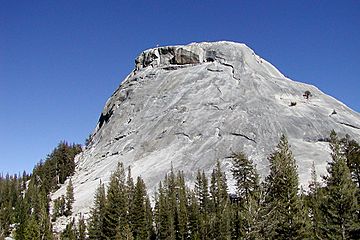Pywiack Dome facts for kids
Quick facts for kids Pywiack Dome |
|
|---|---|
 |
|
| Highest point | |
| Elevation | 8,819 ft (2,688 m) NAVD 88 |
| Prominence | 251 ft (77 m) |
| Geography | |
| Location | Yosemite National Park, Mariposa County, California, U.S. |
| Parent range | Sierra Nevada |
| Topo map | USGS Tenaya Lake |
Pywiack Dome is a well-known rock formation in Yosemite National Park. It's a huge, rounded granite dome that stands about 600 feet (180 meters) tall. You can find it about 0.7 miles (1.1 km) northeast of Tenaya Lake. It's also about 4 miles (6.4 km) west of Tuolumne Meadows and very close to the Tioga Road. Other domes like Harlequin Dome and the North and South Whizz Domes are nearby.
In 1863, Josiah Whitney, who led the California Geological Survey, wrote about Pywiack Dome. He described it as a "very conspicuous conical knob of bare granite." He also noted that its sides were "finely polished and grooved by former glaciers." This shows how ancient glaciers shaped the dome long ago.
Contents
Climbing Pywiack Dome
The west side of Pywiack Dome is a very popular spot for rock climbing. You can easily see several multi-pitch slab climbs from the Tioga Road. These climbs involve going up long, smooth rock faces.
Famous Climbing Routes
One of the first routes, called Dike Route, was climbed in August 1966. It's a challenging 6-pitch climb. Other popular routes include Zee Tree, which is a 5-pitch climb. It's known for being a bit easier, making it a favorite for many climbers. Another route is Aqua Knobby, a 4-pitch climb.
What Does "Pywiack" Mean?
The name "Pywiack" comes from a native language. It means "glistening rocks." The native people used this name for both Tenaya Creek and Tenaya Lake. This was because there were so many shiny, polished rocks in the upper Tenaya area. These rocks were made smooth by glaciers.
How Pywiack Dome Got Its Name
In 1932, the name "Pywiack" was first used for Pywiack Cascade. Before it was called Pywiack Dome, this rock was known by several other names. Some of these names included Murphy's Dome, Teapot Dome, Matthes Dome, Ten-ieya Dome, and Turtle Rock. The name Pywiack Dome was suggested by David Brower in the early 1950s. It first appeared on a map in 1956.
Views






